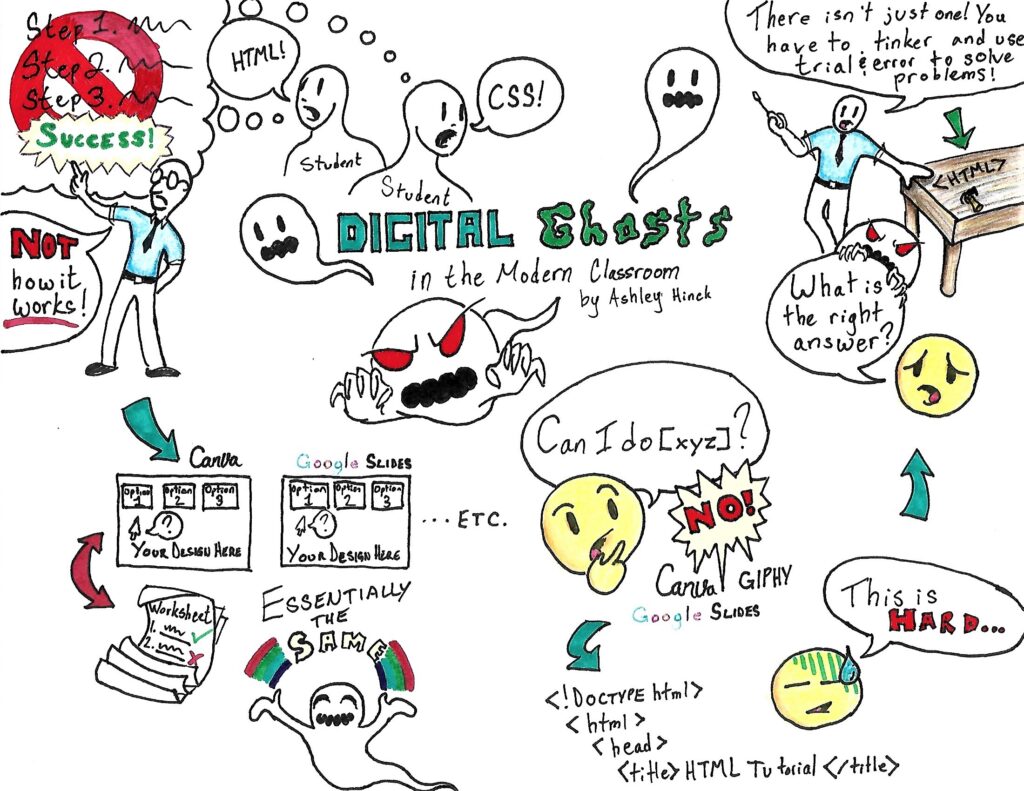A Reflection on Ashley Hinck’s Digital Ghosts in the Modern Classroom

In Ashley Hinck’s article Digital Ghosts in the Modern Classroom, Hinck discusses the various issues people face when working with technology in the school environment. For many students in the past and even today, the bulk of schoolwork is very cut-and-dry. There is one way of doing things; your answer is right or wrong. Worksheets are a classic example of this type of exercise: you fill in the blanks and you get a nice little check mark beside all the blanks you have filled in correctly. It is easy to see where you are successful and where you have failed, and it is not necessary to do much creative thinking in order to achieve top marks.
With the advent of technology, times began to change, however. Teachers began trying to integrate tech into their classes, but while the effort comes from a good place the technology is often misused. Hinck mentions such projects as creating one’s own website — a very valuable skill in this technological age! There are platforms like Wix or Squarespace whichmake building a site easy; simply follow the steps, drag and drop, and presto! A fully-functional website all your own! The problem, as Hinck mentions, is that creativity is severely limited on these platforms. She argues that these methods of creating content are not representative of what creation of web-based content truly is, and I have to agree.
Assignments which use these “Web 2.0” platforms in school only offer the illusion of creativity, always working within the platform’s constraints. They end up being graded in a manner very similar to the worksheets of yesteryear, where you either have a nice-looking website, presentation, etc. which checks all the boxes on the grading rubric, or you don’t. The problem with this kind of activity is that it does not represent true content creation, and does not teach students the skills needed to thrive in this working world: problem solving.
Hinck talks in her article about the countless students she has seen come into her classes ready to learn HTML or CSS, only to be caught off-guard by how hard these languages can be. They become concerned with all of the wrong problems, thinking that because their code or program is not working, they must be wrong. They believe they have failed because for their entire school careers they have been told that there is a set of steps to follow to ensure success, and they end up missing the point of learning these skills in the first place. The real key to these types of activities is the learning process. What matters is whether one is able to identify a problem, fix it, and continue learning. The process is the focus, not the product.
This concept is foreign not only to students, but to many teachers as well. As teachers, we aren’t doing our students any favours by creating product-oriented projects. They will not gain anything by following a set of steps until they reach success, but they will learn valuable lessons by working their way through problems, facing and overcoming failure, and documenting their progress along the way — even the messy parts.
I found this assignment to be very closely tied to the article. It forced me to get out of my comfort zone and try a different approach to an assignment which I had never attempted before. It certainly had its challenges — I had originally planned to do the whole sketchnote digitally using a digital art program and drawing tablet, but I couldn’t get the tablet to work properly and ended up drawing and colouring the entire note by hand. Then I had to find some way to get it from a physical page to a JPEG format on my computer, which was not a step I had expected to face. The process of dealing with these issues taught me about which skills I am already comfortable using (drawing by hand, using a scanning printer) and which skills I will need more time to master (using a drawing tablet successfully, troubleshooting digital art software). Regardless of how successful I may be in the end, the message in the article couldn’t be clearer: students need to learn to value process over product, and that needs to start with teachers (like us, hopefully) who teach their kids how to think.
